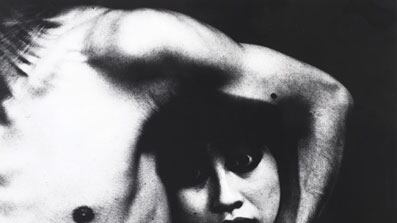Provoke was a short-lived publication founded in Japan in the late 1960s whose pivotal significance on Japanese photography has grown with the years. The Provoke Era, an exhibition at the San Francisco Museum of Modern Art running through December 20, draws from the museum’s prodigious collection of Japanese photography and presents work by more than 20 post-war photographers. While not all were published in Provoke, the constellation of imagery in the show reflects the radical visual ideas that defined the magazine. These photographers defiantly eschewed traditional picture making in favor of an emblematic expressiveness that reads today as both mournful and nihilistic.
Click Image Below to View Our Gallery

The magazine was founded in 1968 by several photographers and writers—Takuma Nakahira, Yutaka Takanashi, Koji Taki, and later Daido Moriyama. It was a turbulent year across the globe and the name alone denotes the tenor of the time as well as the publication’s ideological stance. Provoke’s founders were reacting against the narrative conventions of photojournalism, in particular, an impulse that might be equated to the simultaneous emergence of New Journalism in the Western world as American writers began to insinuate themselves into their own reportage in opposition to the mainstream journalistic orthodoxy. The editors of Provoke were a restless bunch that employed a term for their subversive style, are-bure-boke (rough, blurred, out of focus), an intentional subversion of the optical clarity that had always passed as visual objectivity in the photographic image.
• Art Beast: The Best of Art, Photography, and DesignIn their declaration of intent for the magazine, Taki wrote: “We photographers must use our own eyes to grasp fragments of reality far beyond the reach of preexisting language, presenting materials that actively oppose words and ideas . . . materials to provoke thought.” When Provoke disbanded the following year after only three issues, Moriyama and Nakahira sought the “end of photography,” testing the limits of the medium by photographing ordinary subjects and pushing representation to the point of illegibility. According to Lisa Sutcliffe, who organized the show at SFMOMA, “This rough graphic style reflected the national trend toward rebellion and hedonistic escape from the tensions of the recent past.”
Following World War II, the United States occupation in Japan lingered and the term for it, Americanization, came to signify the introduction of Western popular culture and modern consumerism in contrast to the old-world customs of a deeply militaristic culture. It was not an easy marriage of tradition and modernity. While the collective upheaval of the status quo in the late 1960s reached Japan, it only stirred up the complicated internal cultural transformation that was already underway.
Several Provoke photographers were children during World War II and were obviously influenced by the atomic age. Shomei Tomatsu, for example, experienced the destruction of Nagoya, his home city, as a teenager. Refusing to go into the bomb shelters, he watched planes invading and bombs exploding like fireworks from his second-floor bedroom window.
Perhaps the most literal reflection of the effects of the nuclear era on Japanese society is “Atomic Bomb Damage: Wristwatch Stopped at 11:02, August 9, 1945, Nagasaki,” a picture by Tomatsu. But the title of the exhibition itself might well refer to the elegiac quality of so much photographic work made in Japan in the decades following the war. “Kanaitachi, # 31,” by Eikoh Hosoe, for example, shows a figure running under a corona that evokes the iridescent glow of the atomic bomb, while “La Nuit, 5,” by Takuma Nakahira, and “Route 16,” by Daido Moriyama depict streaks of light outlining objects or figures as if they were radiating from an exploding bomb.
Moriyama, among the photographers most widely exhibited in the U.S., had apprenticed to both Hosoe and Tomatsu. The greater influences he has often cited, though, are Robert Frank and William Klein. “My approach is very simple—there is no artistry, I just shoot freely,” Moriyama said in a statement for his exhibition at The Japan Society in New York in 1999. “For me, photography is not about an attempt to create a two-dimensional work of art, but by taking photo after photo, I come closer to truth and reality at the very intersection of the fragmentary nature of the world and my own personal sense of time."
In 1974, John Szarkowski organized a show called New Japanese Photography at the Museum of Modern Art. He put his finger on the subtle generational differences between Tomatsu and Moriyama in his catalogue essay, writing, "The suggestion of the nihilistic that exists in Tomatsu's work has been made boldly and effectively explicit by Moriyama.... [W]hat in the older man is a sense of tragedy becomes in the younger an occult taste for the dark and frightening.”
What could be darker and more frightening than bombs exploding all around you? That fear—and its attendant dissociation—is what speaks loudest in the haunting photographs of the Provoke Era.
Plus: Check out Art Beast for galleries, interviews with artists, and photos from the hottest parties.
Philip Gefter was a picture editor at The New York Times and wrote regularly about photography for the paper. His book of essays, Photography After Frank, was recently published by Aperture. He is currently producing a feature-length documentary on Bill Cunningham of the Times, and working on a biography of Sam Wagstaff.





